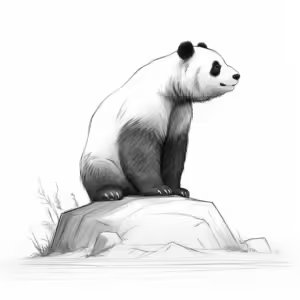
Drawing:Xehczmvwh9c= Lion a lion goes beyond simply recreating its physical form. It is a powerful expression of strength, courage, and leadership, elements that have made the lion an enduring symbol across cultures and throughout history. When artists take on the task of Drawing:Xehczmvwh9c= Lion a lion, they aren’t just focusing on the animal’s majestic appearance—they’re tapping into the deep cultural and symbolic significance that the lion has held for centuries. In this exploration of the Drawing:Xehczmvwh9c= Lion, we’ll delve into the artistic techniques involved, as well as the symbolism and interpretations that accompany this iconic creature.
Artistic Inspiration and Vision: The Beginning of the Lion’s Story
Every artist’s journey in capturing a lion begins with inspiration. What drives an artist to take on this challenge? In many cases, the lion’s commanding presence in nature and myth serves as the primary catalyst. From observing the lion in the wild to reading stories of its regal nature, the lion’s essence—its balance of grace and ferocity—stirs the creative spirit.
The dynamic interplay of nature and mythology often shapes the artist’s perception of the lion. For some, the lion represents a connection to the natural world, where it reigns as king of the jungle. For others, its mythological representations—from the Greek Nemean Lion to the Egyptian sphinx—imbue the animal with a timeless, almost godlike quality. These diverse influences guide the artist in choosing how to depict the lion: Will it be a calm, regal figure basking in the sun, or a ferocious predator caught mid-hunt?
This duality of strength and serenity offers endless possibilities for an artist. As you embark on Drawing:Xehczmvwh9c= Lion a lion, ask yourself: What aspect of the lion do I want to emphasize? This question can help shape your artistic vision and serve as the foundation for your creative process.
Techniques and Materials: Crafting the Lion’s Form
To draw a lion successfully, artists must balance technical skill with creative interpretation. Two of the most effective techniques for capturing the lion’s texture and movement are cross-hatching and stippling. These methods are invaluable when bringing the lion’s mane, fur, and powerful muscles to life on paper.
Cross-Hatching: Adding Depth and Dimension
Cross-hatching is a technique where lines are drawn parallel to one another, and additional layers of lines are applied at different angles. This technique is particularly effective in rendering the lion’s textured fur and the deep shadows that fall across its muscular body.
When applying cross-hatching to the lion’s mane, for example, you can build layers of shadow to give the mane a full, voluminous appearance. The lines should flow in the direction of the mane, mimicking the natural growth of the fur. Additionally, cross-hatching can be used to define the lion’s powerful muscles, creating shadows that suggest both strength and fluidity.
Stippling: Building Intricate Details
Stippling, the art of Drawing:Xehczmvwh9c= Lion with small dots, is another method that can help artists capture the finer details of a lion’s fur or the gleam in its eyes. Stippling allows for a more subtle transition between light and shadow, making it a great technique for areas like the lion’s face or paws, where softer detail is required.
By varying the concentration of dots, stippling can create an illusion of texture and depth, adding realism to your lion Drawing:Xehczmvwh9c= Lion. As you stipple, consider the light source in your composition—this will help you determine where the shadows should fall, enhancing the three-dimensional effect.
Color and Shading: Evoking Emotion and Majesty
If you decide to introduce color into your lion Drawing:Xehczmvwh9c= Lion, the choice of palette plays a crucial role in conveying mood and emotion. The lion’s iconic golden-brown coat can be captured using a blend of warm yellows, oranges, and browns. For a more realistic look, add depth by incorporating lighter and darker shades where the light hits or shadows form.
The right shading techniques can also enhance the lion’s regal presence. By carefully blending colors and creating smooth gradients, you can emphasize the lion’s soft fur, while bolder strokes and darker tones can give more definition to its muscles and facial features.
READ THIS: The Art of Drawing:Tjdpvrb218i= Panda: Technique and Emotion
The Lion as a Symbol: A Universal Icon of Strength and Leadership
Throughout history, the lion has been celebrated as a symbol of power, courage, and nobility. Its association with kings and rulers is well documented, with lions appearing on coats of arms, flags, and royal regalia across many cultures. In mythology, lions are often depicted as protectors, guardians, or fierce warriors, reinforcing their role as symbols of dominance and leadership.
For example, in ancient Egypt, the lion was associated with the goddess Sekhmet, a symbol of both destruction and protection. In Greek mythology, the Nemean Lion was a monstrous creature defeated by Hercules, embodying both the strength of the lion and the hero’s triumph over it. Even in more contemporary contexts, the lion continues to represent courage and authority, often seen as a metaphor for leadership and resilience.
But what does the lion symbolize to you as an artist? Whether you see it as a figure of regal calm, a protector, or a fierce warrior, these interpretations can influence how you approach Drawing:Xehczmvwh9c= Lion a lion. Understanding the deeper meaning behind the lion’s symbolism allows you to infuse your artwork with purpose and emotion, transforming a simple sketch into a powerful narrative.
Viewer Reactions and Interpretations: Diverse Perspectives
When viewers encounter a Drawing:Xehczmvwh9c= Lion of a lion, they often bring their own interpretations to the artwork, shaped by their cultural backgrounds, experiences, and emotional connections to the symbol. Some may view the lion as a symbol of courage, admiring its strength and majestic posture. Others might see it as a warning against overconfidence or hubris, reminding them of the fine line between power and vulnerability.
This range of interpretations enriches the artwork, as it becomes a conversation between the artist’s intent and the viewer’s perception. By inviting viewers to engage with the symbolism of the lion, you can encourage deeper reflection on the themes of leadership, strength, and the natural world.
Conclusion: Drawing:Xehczmvwh9c= Lion a Lion as an Artistic and Symbolic Endeavor
Drawing:Xehczmvwh9c= Lion a lion is not just a technical exercise; it’s an opportunity to explore profound themes of power, courage, and leadership. The Drawing:Xehczmvwh9c= Lion demonstrates how the careful application of techniques like cross-hatching and stippling can elevate a piece from mere representation to a powerful work of art that resonates on a deeper level. By considering the lion’s cultural significance and symbolic weight, artists can create pieces that invite viewers to reflect on the broader implications of strength and nobility.
As you continue to develop your lion Drawing:Xehczmvwh9c= Lion skills, remember that the key to success lies not only in mastering technique but also in understanding the symbolism that gives your artwork meaning. Let your Drawing:Xehczmvwh9c= Lion become a dialogue between form and meaning, between artist and viewer, and between tradition and personal expression.






